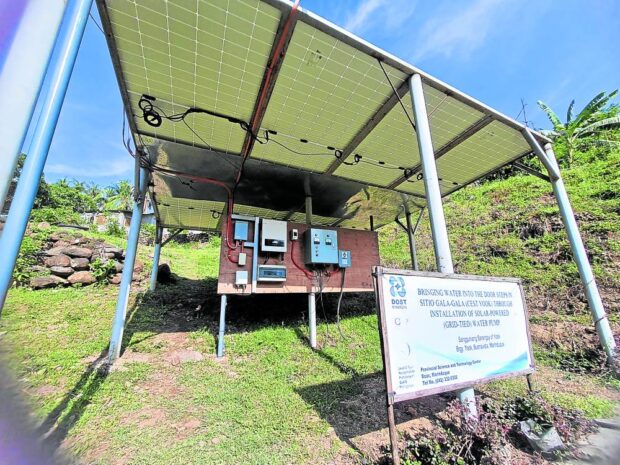
TECH-DRIVEN SOLUTIONS | Solar panels installed at Barangay Yook. (Photo by KRIXIA SUBINGSUBING / Philippine Daily Inquirer)
MANILA, Philippines — In Marinduque province, residents had been coping with a contradiction in their environment all their lives.
Like Tantalus, the king in Greek mythology who offended the gods and was made to endure being eternally thirsty even though he was surrounded by water, people on the main island of Marinduque and its surrounding 14 islets didn’t have easy access to potable water — until renewable technologies were recently introduced in the province.
Take, for example, the islet village of Mongpong, off the northeastern coast of Marinduque Island. For a long time, the estimated 1,300 people who live there had to cross the sea to Marinduque, and sometimes to the neighboring island province of Romblon, in order to buy water at P60 a container.
It’s either that or they prayed for rain to fill their earthenware jars, called tapayan.
In the village of Yook, located in Mt. Malindig on the southern tip of Marinduque Island, residents once had to go down the mountain and take a tricycle ride to another sitio to get water, then trek back up.
Water refilling and desalination station at Mongpong. (Photo by KRIXIA SUBINGSUBING / Philippine Daily Inquirer)
Science-based solutions
According to Gov. Presbitero Velasco Jr., other islands in the country also face this situation of not having drinking water within their reach.
But the people of Mongpong and Yook have come up with science-based solutions to help ensure water security in their isolated communities.
“We’re trying to expand on projects for water and environment [in those areas],” Science and Technology Secretary Renato Solidum said in an interview. “Water security is a priority under this government.”
In 2021, the Department of Science and Technology (DOST) introduced in Mongpong a desalination system converting seawater into potable water.
It was the first time for the DOST to fund such a project, which is used in many island communities around the world and even in ships embarking on long sea voyages.
Keith Buenaventura, a science research specialist of the DOST in the Mimaropa region (Mindoro, Marinduque, Romblon, and Palawan provinces), said desalination is still “relatively unknown” in the Philippines, as many coastal villages continue to rely on rain for their drinking water.
The technology, which is estimated at P3 million, applies force to push seawater through a desalination membrane to filter out salt and other particles, which are pumped back into the sea.
Buenaventura said residents in Mongpong “wanted to take advantage” of such a project, so it could also serve as an example to other island provinces in the country.
True enough, Occidental Mindoro and Romblon as well as Catanduanes in the Bicol region are now also availing themselves of desalination.
Water refilling and desalination station at Mongpong. (Photo by KRIXIA SUBINGSUBING / Philippine Daily Inquirer)
Daily supply
The system in Mongpong currently operates eight hours a day to produce 100 liters of drinking water.
Bernardo Caringal, the DOST director in Marinduque, said this daily supply is enough for the village.
The desalinated water is put in containers big enough to store five liters each. Mongpong has also earned a modest income to maintain the project, selling each container at P20.
But students can get free water before going to school.
Victoria Relano, Mongpong’s barangay chair, said the project has “made such a huge impact on our lives as we can now spend on other needs.”
“For example, in our household of six, we often needed three containers that cost [a total of] P180,” she said. “What happens to fisherfolk like us, who sometimes only earn P100 a day? Now we can use the [money] to put food on the table.”
‘Straight to the homes’
Buenaventura said the system in Mongpong still runs on electricity, but the villagers hope to tap solar power soon.
Meanwhile, Yook began using solar energy this year with the assistance of the DOST. Solar panels direct the heat to help pump up the water, so that the residents no longer have to haul containers up and down the mountain.
“The idea is to bring the water straight to the homes,” said DOST science research specialist Joseph Manaog. “We’re also hoping to inspire the residents to consider renewable energy, especially [since] brownouts are another problem here.”
Yook village chair Gemma Perlas recalled how difficult it was to get water to wash the dishes, take a bath and feed the farm animals.
“This was especially hard because we had children who needed to go to school,” she said. “Not only did we have to collect water early in the morning but it was often a race because sometimes water also runs out if you’re slightly late.”
Talks with private sector
The Mongpong and Yook projects need more funds for their maintenance.
But Velasco said the provincial government is in talks with the private sector “to ensure water supply” in these villages.
He also said desalination projects and a rainwater collection system are being planned for other communities in the province.
“For most of our lives we relied on the rain to bring us water, and now it’s come to us,” Relano said about her barangay. “It has really changed our lives.”